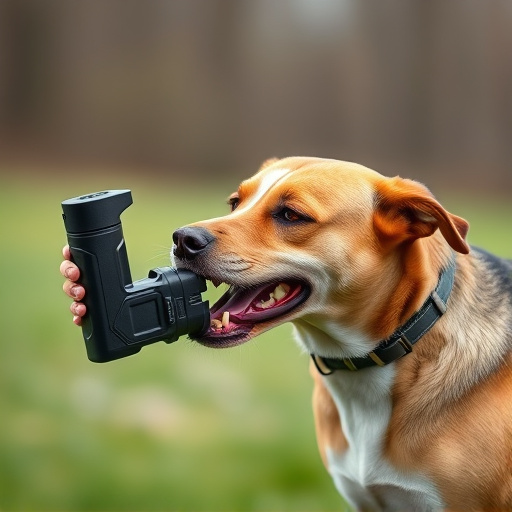Mace spray, primarily composed of capsaicin from chili peppers, is a versatile self-defense tool against aggressive dogs. Its active ingredient irritates eyes and respiratory systems, temporarily incapacitating animals without severe harm. Formulations are refined to disrupt an animal's sensory system, with innovations in capsaicin concentration, surfactants, and other chemicals. Pepper spray effectively manages canine aggression, causing temporary non-threatening conditions through targeted deployment on the face and eyes. Safety measures include using products specifically formulated for animals with lower concentrations and wearing protective gear. Responsible usage involves understanding local regulations and handling techniques for effective dog control.
“Discover the power of pepper spray as a non-lethal animal control solution, especially in managing aggressive dogs. This article delves into the science and effectiveness of pepper spray formulations tailored for canine behavior. We explore how these sprays work against dogs, dissecting the chemistry behind their potency. Additionally, we provide practical use cases, safety guidelines, and expert tips to help you choose the right pepper spray for dog control, ensuring both animal welfare and public safety.”
- Understanding Mace Spray and Its Efficacy Against Dogs
- The Science Behind Pepper Spray Formulations
- Effective Use Cases and Safety Measures
- Choosing the Right Pepper Spray for Dog Control
Understanding Mace Spray and Its Efficacy Against Dogs
Mace spray, a versatile self-defense tool, has gained attention for its potential in animal control, especially against aggressive dogs. The primary active ingredient in mace spray is capsaicin, a chemical derived from chili peppers. This substance irritates the eyes, nose, and respiratory system of animals, including dogs, providing a non-lethal means of deterrence. The effectiveness of mace spray lies in its ability to disrupt an animal’s balance and coordination by triggering a strong reaction to the irritant.
When it comes to handling aggressive dogs, pepper spray formulations are designed to quickly incapacitate them without causing severe harm. The spray creates a temporary yet powerful barrier, allowing individuals to create distance or seek assistance. While not all dog breeds react equally to mace spray, its reliability in de-escalating potentially dangerous situations makes it a preferred choice for animal control professionals and individuals seeking effective, yet humane, methods of defense against aggressive canine behavior.
The Science Behind Pepper Spray Formulations
The science behind pepper spray formulations, specifically tailored for animal control, especially against aggressive dogs, is a blend of chemical knowledge and practical application. These mace sprays are designed to disrupt the normal functioning of an animal’s sensory system, particularly its eyes, nose, and throat. The key component in most pepper spray formulations is capsaicin, the compound that gives chili peppers their heat. When sprayed, capsaicin irritates nerve endings, triggering a chain reaction that results in pain, temporary blindness, and difficulty breathing.
Researchers continuously refine pepper spray formulations to enhance their effectiveness while minimizing non-target effects. This involves adjusting the concentration of capsaicin, adding surfactants for better adhesion to fur and skin, and incorporating other chemicals to improve the spray’s range and persistence. These innovations ensure that animal control officers have a powerful tool to handle aggressive dogs safely and humanely, making interactions more manageable and reducing risks for both humans and animals.
Effective Use Cases and Safety Measures
When it comes to effective animal control, pepper spray has proven to be a game-changer, especially in dealing with aggressive dogs. The key lies in its formulation and potency. Modern pepper spray used for animal control is designed with a powerful yet targeted active ingredient—capsaicin—which disrupts the dog’s sense of smell and vision, temporarily rendering them non-threatening. This non-lethal method has been widely adopted by law enforcement and animal control officers due to its swift action and minimal risk to both humans and animals.
Safety measures are paramount when using pepper spray against dogs. It’s crucial to ensure the product is specifically formulated for animal use, with a lower concentration than standard self-defense sprays. Officers must also wear protective gear, including eye protection, as a stray mist could cause irritation. Proper training ensures that the spray is deployed accurately and responsibly, aiming for the dog’s face and eyes to disable without causing prolonged harm. This method is particularly useful in de-escalating potentially dangerous situations, allowing for safe capture and relocation of aggressive canines.
Choosing the Right Pepper Spray for Dog Control
When considering pepper spray for dog control, it’s crucial to select a product tailored to aggressive canine behavior. The effectiveness of pepper spray lies in its formulation—a key factor in deterring dogs. Look for sprays designed specifically against aggressive dogs, as these often contain higher concentrations of capsaicin, the active ingredient responsible for the burning sensation. This potent formula can help control and de-escalate situations without causing lasting harm to the animal.
Additionally, consider factors like spray range and duration, as well as weather conditions, which can impact performance. Water-resistant options are ideal for outdoor use, while those with longer-lasting effects provide more time to safely manage an encounter. Remember, proper handling and knowledge of local regulations regarding pepper spray usage are essential for responsible and effective dog control.
When it comes to managing aggressive dog behavior, a well-formulated pepper spray can be an effective animal control tool. The science behind these sprays ensures their potency and safety when used appropriately. By understanding the dynamics of dog aggression and selecting the right product, such as those designed for canine deterrence, individuals can navigate potential risks and maintain a secure environment. Remember, proper application techniques and safety precautions are paramount to making pepper spray a reliable solution in dealing with aggressive dogs.
